

A CASE FOR SUPPORT
UC Comprehensive Stroke Center
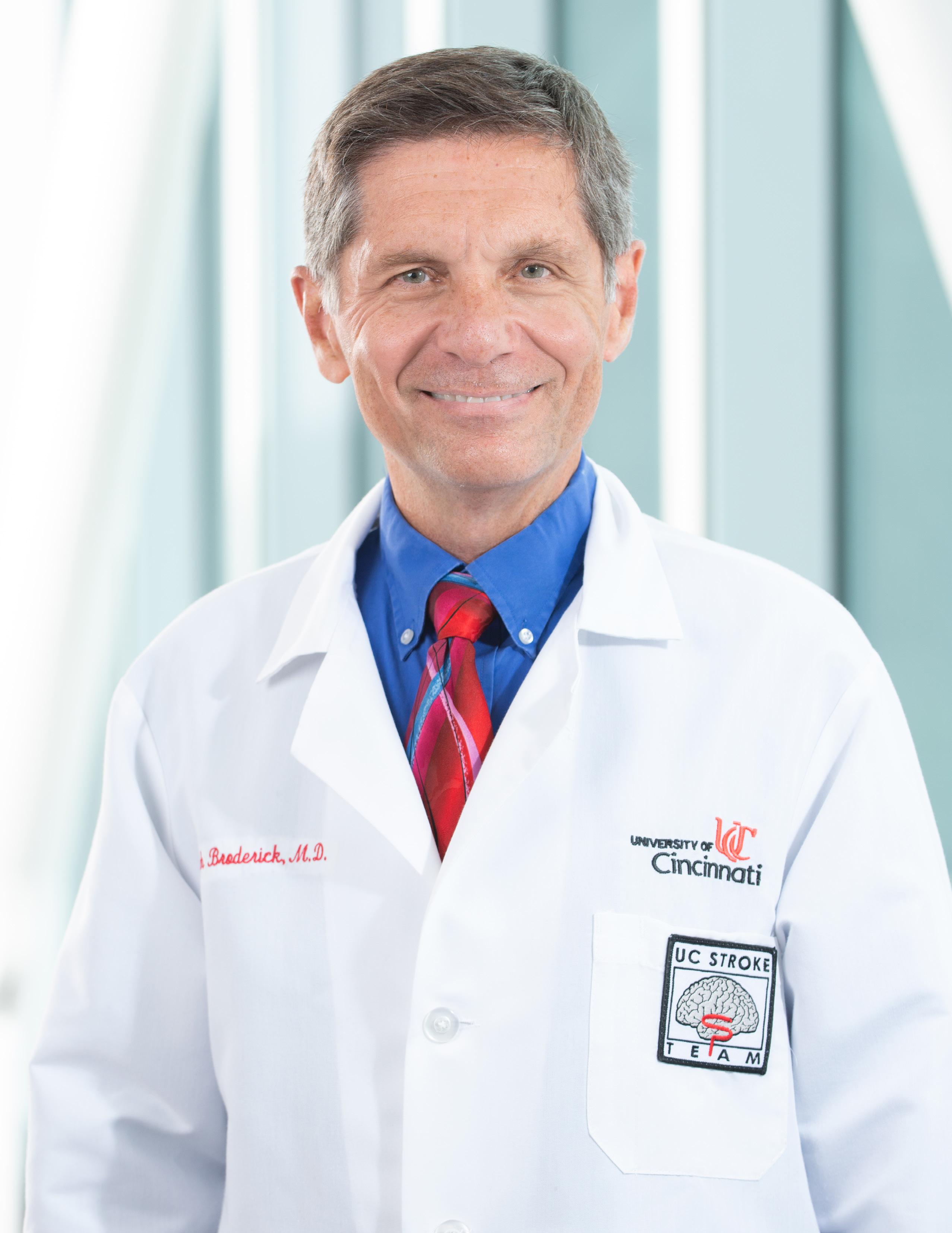
“When I joined the UC Stroke team in 1987, UC was part of the first pilot trial of tissue plasminogen activator (tPA). We started seeing results in patients and knew it was going to change medicine. This trial led to the 1996 FDA approval of tPA as the first stroke treatment, which went on to become the ‘gold standard’ of care for ischemic strokes.”
JOSEPH BRODERICK, MD Professor of Neurology and Director, UC Gardner Neuroscience Institute
Dear Friend,
The University of Cincinnati Comprehensive Stroke Center is an international leader in stroke treatment and research. We provide advanced specialty care with a multidisciplinary approach for patients with the most challenging cases—both emergent and elective treatments.
Comprised of neurologists, neurosurgeons, neuroradiologists, emergency physicians and neurocritical care physicians, our team treats all cerebrovascular disorders including ischemic stroke, hemorrhagic stroke, carotid stenosis, brain vascular malformations and brain aneurysms.
At the UC Gardner Neuroscience Institute, the Stroke Center:
• Is an Advanced Comprehensive Stroke Center, among just 4% of hospitals in the U.S. with specific abilities to treat the most complex stroke cases.
• Is the national coordinating center for StrokeNET, designing and managing all multicenter clinical trials for the National Institutes of Health (NIH) network of >300 clinical sites. This includes comprehensive oversight of 21 current research studies in acute stroke treatment, prevention and recovery.
• Is home to the most innovative and sought-after research fellowship training programs in the country, including cerebrovascular and neurocritical care.
• Leads the largest and longest study of stroke that tracks how stroke occurrence and survival has evolved across the U.S. and our region. Data from this study are used for national statistics of stroke frequency and outcomes. UC additionally runs one of the largest studies of genetic risk in brain bleeds, to better understand inherited risk/risk to family members.
Our vision is to continue to lead as a global model for stroke centers, by driving new discoveries and delivering personalized care. We are grateful for your consideration to partner with our team in support of this important work that will improve lives here in Greater Cincinnati and around the world.
Stacie L. Demel, DO, PhD
Associate Professor of Neurology
Co-Director Vascular Neurology Division
Co-Director, UC Stroke Team
Eva Mistry, MD, MSc
Associate Professor and Vice Chair of Research
Co-Director Vascular Neurology Division
Charles J. Prestigiacomo, MD
Professor of Neurological Surgery Director of Cerebrovascular and Endovascular Surgery
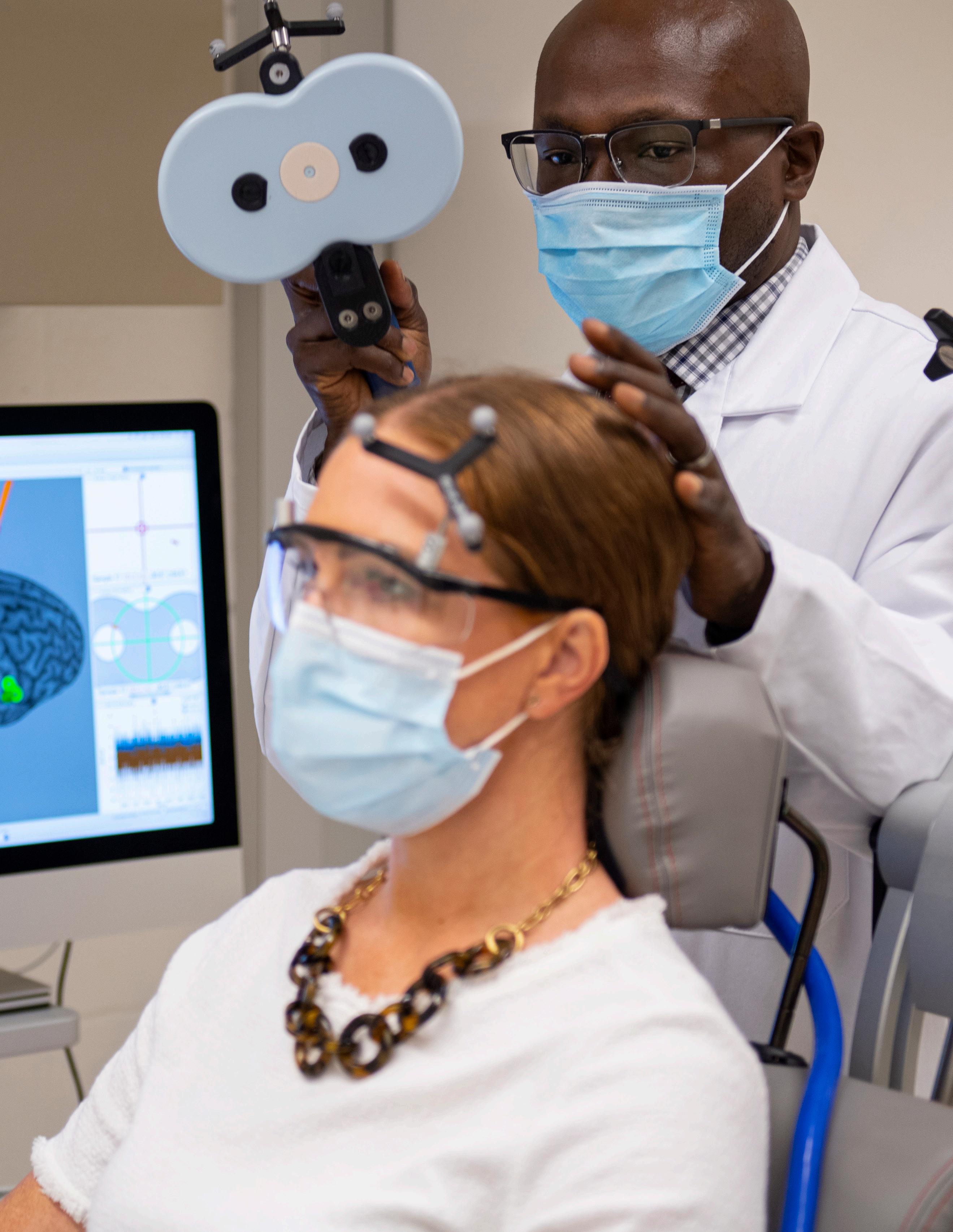
RESEARCH
Growing and retaining top talent
At the UC Gardner Neuroscience Institute, our faculty leaders bring an evidence-based focus to everything we do. To attract rising-star researchers and expand our quests for discovery, we must evolve our resources to maintain the fast pace required for continual health care innovation.
Endowed chairs for clinical leadership and research faculty
Historically, endowed chairs were a want-to-have luxury, today they are a need-to-have tool in order for UC to be competitive with other nationally ranked academic medical centers. Chairs are essential to our ability to recruit and retain top talent among a competitive field of other neuroscience institutes. Establishing new chairs builds permanency and sustainability in our areas of excellence:
• Clinical leadership to advance the subspecialty care areas of stroke, neurorecovery and rehabilitation medicine.
• Neuroscience research chairs to expand clinical trials and basic neuroscience research, to enable the discovery of new medications and treatments and protect time for physician-scientists to balance patient care with research and teaching. An endowed research chair allows us to recruit new thought leaders or retain vital faculty and ensures continuity of important research efforts at the university.
Paired with our advanced facilities and research operations, endowed chairs will attract nationally and globally recognized faculty to the UC Gardner Neuroscience Institute. This accelerates the research and development of new treatments, all to directly benefit more patients.

Expanding research for improved outcomes
MRI research technology
MRI scans are now a key component of clinical research trials at the neuroscience institute—including in stroke, Parkinson’s disease, epilepsy, memory and mood disorders. Neuroimaging research allows a physician or researcher to evaluate a patient’s baseline or see how they respond to new medications or therapies. To support our robust research efforts, the institute is in need of a dedicated research scanner.
An MRI focused entirely on research, with staff trained in neuroinformatics and the latest imaging techniques, will broaden our discovery efforts across all specialty areas. The outpatient facility (that opened in 2019) was built to accommodate an additional MRI with researcher staffing space.
Stroke research through radiology
UC researchers are leading a large multicenter study to understand if certain biomarkers can help predict the likelihood of recovering motor functions following a stroke. Through the use of MRI in stroke survivors, the research team will test for biomarkers to look at where in the brain tissue the stroke occurred.
Research endowment fund
Neuroscience is the most prolific research area throughout the academic health center and the entire university. Creating a substantial research endowment will encourage further cross-disciplinary projects across departments and centers and can spark “high-risk/highreward” ideas that are less likely to find support through conventional grant funding.
Pilot grants are the mustard seeds of research. Their results lead to much larger grants from the National Institutes of Health and other external foundations.
For example, $925,000 in pilot grant funding from 2014 to 2020 resulted in $16,236,369 in monies from the government and external foundations—a 17 to 1 return on investment.
A research endowment fund is critical to progress and will allow investigators to pursue more novel, long-term and untested research projects, giving them the security to take the risks that will yield breakthrough discoveries right here in Cincinnati.



What is clinical research?
It is the study of medicines, devices, products or treatments to determine safety and effectiveness for potential human use. Clinical research may be used for prevention, diagnosis and treatment, or for relieving symptoms of a disease.
Benefits of clinical trials
For patients
• Access to a novel treatment that isn’t yet available and could improve the patient’s quality of life.
• Regular and attentive care while contributing to research that may save lives in the future.
For physicians and scientists
• Driving exciting advances in patient care, discovering new treatments.
• Improving the standard of care and patient quality of life.
Stroke research: faster treatments, better recovery
At the UC Gardner Neuroscience Institute, we are exploring innovative new approaches to prevention, treatment and recovery of stroke. Our research seeks to both understand the individual patient and to pinpoint the causes of a stroke through a precision medicine lens in order to develop new, effective therapies.
Stroke is one of the leading causes of death and disability in the U.S., but there are very effective treatments if administered soon after symptoms start. Patients suffering an acute ischemic stroke typically experience an abrupt onset of symptoms, including weakness, numbness and changes in vision and/or speech.
As the National Coordinating Center of StrokeNet, UC serves as the primary infrastructure for multicenter trials of stroke funded by NIH and the pipeline for new potential treatments for adults and children with stroke and those at risk for stroke.
These studies have led to significant advances in patient care worldwide. For example, a study published in 2018 improved acute stroke care by determining that endovascular therapy (clot removal) had better long-term outcomes in patients than just medical therapy alone when acute ischemic stroke patients are beyond the conventional window of treatment. The study received a U.S. congressional award for the significance of its impact upon patient care.
Expanding new stroke treatments
A new treatment for acute ischemic stroke has been implemented region-wide by the UC Stroke Team. Tenecteplase (TNK) is a protein that can break up blood clots. It is a powerful clot-busting medication administered to patients who experience a stroke caused by a sudden blockage of an artery that supplies blood to the brain.
• One key advantage of TNK is how quickly it can be given to a patient. Where tPA takes about an hour via infusion, TNK can be prepared and injected in seconds.
Research indicates that it treats stroke cases faster and more effectively than our current treatments for stroke (tPA)—and our team has led the charge to expand its use to help more patients in our tri-state region.
“Philanthropy has driven our research and funded scores of breakthrough pilot grants. Because of these investments, we have been able to pioneer the next generation of stroke therapies in acute treatment, prevention and recovery. We are truly on the precipice of new milestones in stroke research."
EVA MISTRY, MD, MSc Associate Professor of Neurology
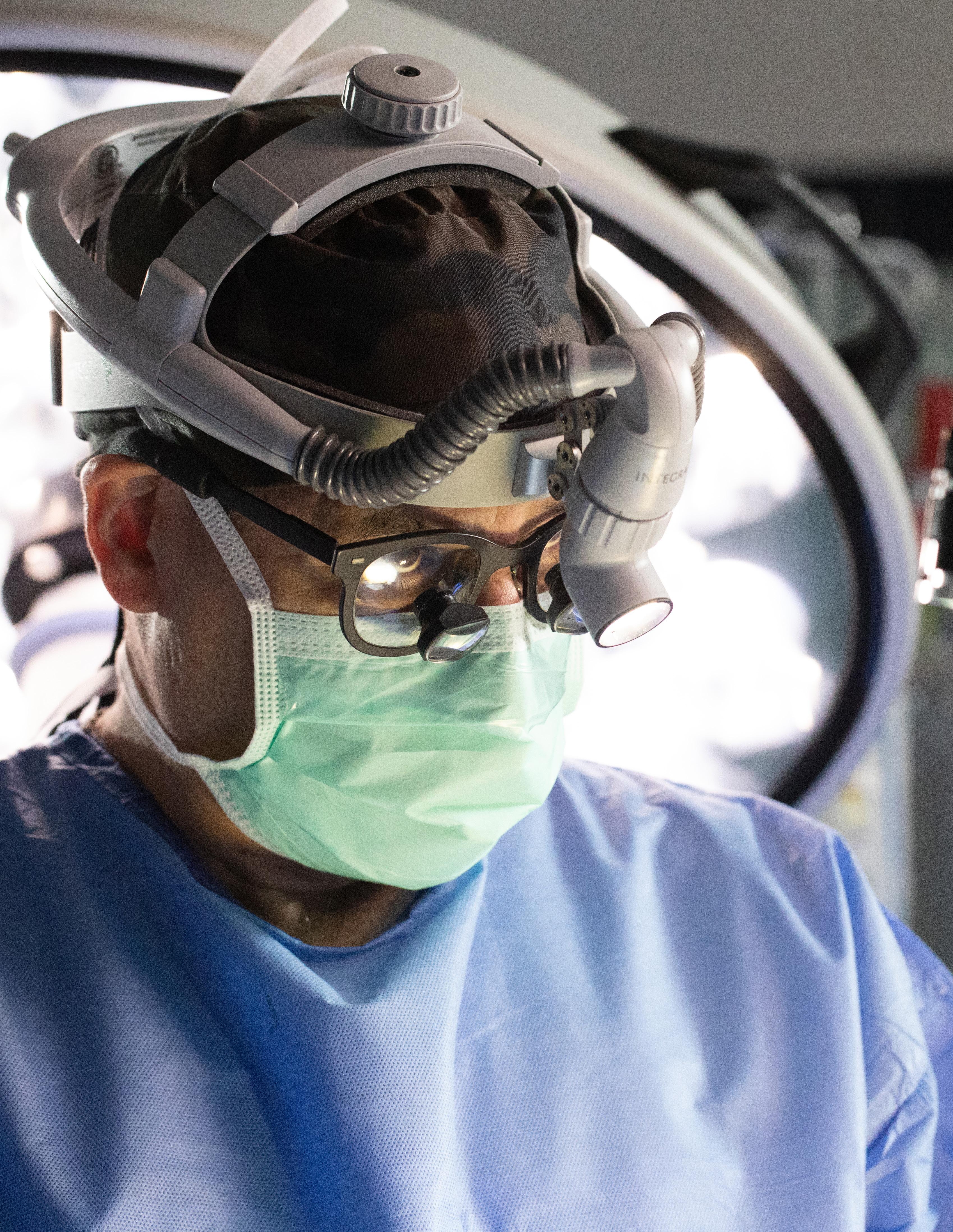
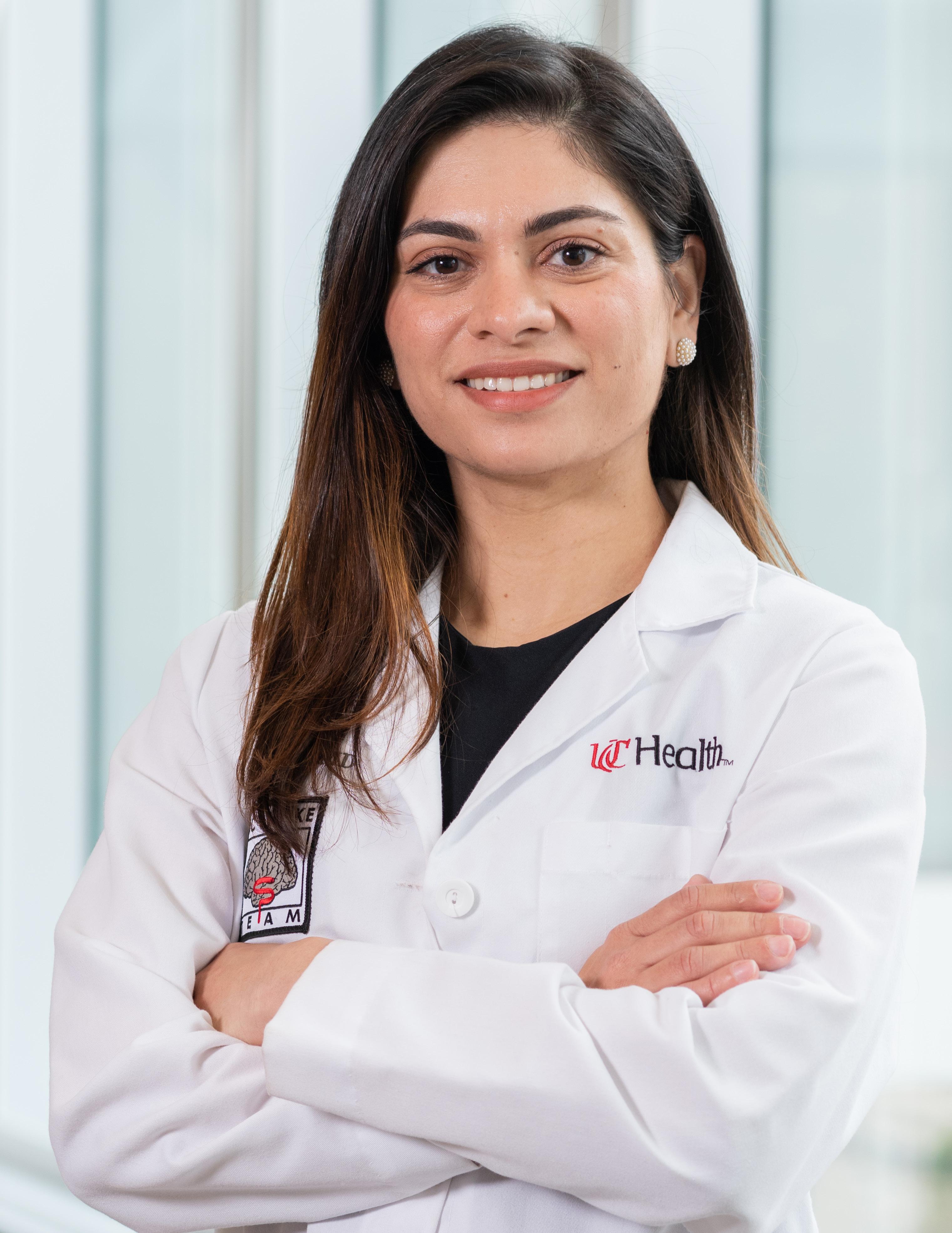
Studying advancements in removing blood clots when stroke occurs
Studies of medical therapy options have greatly benefited the way we identify, assess and treat strokes today. Clinical trials open avenues for further study and improvement across all of stroke care.
One of the key methods to advancing stroke care is through the study of new devices and techniques to remove blood clots when stroke occurs, and to restore blood flow as soon as possible.
UC investigators have been at the forefront of effective therapies, such as clot removal techniques for the most severe strokes. Our stroke team currently leads 48 centers in a collaborative platform trial to improve patient outcomes by evaluating devices and drugs that will open blocked arteries safely and quickly. This is a first in translational stroke research worldwide.
Additional funding will propel our research into the next phase, and speed the implementation of new proven techniques to improve patient care.
Neurorecovery:
Improving life after stroke
As research, treatments and awareness have advanced, more and more people are surviving strokes. However, nearly half of stroke survivors do not regain full functional independence.
This has prioritized our care teams’ approach to survivorship and how patients must often adjust to a new way of life.
The UC Neurorecovery Lab team empowers stroke survivors and family caregivers to enhance their quality of life through the study of new interventions, and to better understand the brain-behavior relationship and the overall stroke recovery process.
Our researchers are studying how the brain functions during specific tasks such as walking or speech. This is possible through cutting-edge and versatile wearable technology called near-infrared spectroscopy (fNIRS). The wealth of data acquired from this technology will accelerate our understanding of neuroplasticity, or how the brain can repair itself and make new neural connections. It will also provide insight into which areas of the brain to target to optimize treatment response in future studies.
Philanthropic investments will allow us to continue to build our research around these initiatives, by enrolling more patients in our studies. The expansion and acceleration of our research will lead to faster and better outcomes, greater likelihood of patient recovery and early intervention and prevention before a stroke occurs.
CLINICAL CARE
Grow our patient data infrastructure, strengthen services for our centers of excellence, creating a national destination for care
The power of big data: Improving patient outcomes
To offer truly world-class care for our patients, we need to rely on not just the expertise of one doctor, but leverage the expertise of every single doctor in our institute and beyond. We must continue to scale our approaches to personalized treatment for our patients, understanding that care is unique to each individual.
With the vast amount of health data now available, a physician has millions of data points at their fingertips. The flow of new information never stops as biomedical knowledge from new research doubles every 73 days. However, the time lag from putting new knowledge into practice currently takes more than a decade.
The UC Gardner Neuroscience Institute is building an integrated network of research, clinical data and quality improvement processes that will rapidly deliver new learnings to the bedside, vastly improving patient care and quality and longevity of life.
This network will connect all of our centers of excellence, and eventually connect us to peer neuroscience institutes like the top-ranked Weill Institute at UC San Francisco. These connectors multiply the expertise of our institute, identifying new approaches and treatments that will improve patient outcomes not only in our region, but worldwide.
Adopting a big data approach to care
Before
• Average 17 years from evidence to practice.
• Lacks patient input and learned experience.
• Disparities in practice, decision-making.
• Measures process with outcomes.
After
• Less than 3 years to apply new evidence to patient care.
• Patient-driven research and resources.
• Aligned use of best practices, efficient and accessible evidence.
• Measures real-time patient outcomes, to continuously modify care.
Leveraging big data
This approach to care will measure real-world outcomes from our patients and make immediate and continuous improvements to the system as a result. Our leaders have already demonstrated how an integrated, data-driven approach can optimize patient outcomes for epilepsy and mental health care.
For example, in partnership with the Emergency Department, the UC Stroke Team is collecting data to improve treatment times for stroke patients. By gathering patient information, like severity of condition, time of arrival to time of medication received and other aspects of patient case management, we can evaluate how to speed our time to treatment—Within a year, our teams were able to double the number of patients treated for stroke at UC Medical Center in under 45 minutes (from 37% to 71% of stroke patients seen).
“Getting to the truth of a patient’s problem and how best to cure it, requires data scientists, analysts and biostatisticians—people and tools that aren’t normally part of the healthcare model. And I think this is where philanthropy and the generosity of our community and patients can make a big impact.”
JOSEPH CHENG, MD Associate Director for UC Gardner Neuroscience Institute
Frank H. Mayfield Endowed Chair
& Professor
of Neurosurgery


“For all of our major accomplishments in clinical care and research, educating the next generation of clinicians and researchers on how to provide the best care for patients and the best science to advance our field will have a legacy effect for decades to come.”
CHARLES J. PRESTIGIACOMO, MD Professor of Neurological Surgery Director of Cerebrovascular and Endovascular Surgery
Enhanced clinical services
As the leading center for stroke care in the region, expanding talented, highly trained staff is crucial to provide the most comprehensive stroke care to our patients and their caregivers. In addition to our physician leaders, these key roles include:
• Social workers who provide critical care and guidance to community and other resources for our patients, particularly those managing complex conditions.
• Nurse navigators who provide an essential core of clinical expertise and help transitions from hospital back to clinical setting.
• Clinicians who care for patients after hospitalization until they can be transitioned to their primary care provider for management of stroke risk factors.
As our patient outcomes continue to excel, new technology and comprehensive services in support of the whole person will evolve across the institute.
Our current priorities include:
• Software to improve the patient journey, upgrading our ability to seamlessly communicate with patients.
• Brain health longevity program to offer in-depth neurological assessments for signature world-class preventative care.
• Stroke prevention and recovery programs in partnership with the Osher Center for Integrative Health at UC, offering complementary therapies and counseling for nutrition and wellness.
EDUCATION
Building excellence in care, training, specialized staffing
In the hospital setting, talented nurses, resident physicians and support staff often spend more time with patients and families than the attending physicians. These expert care teams provide compassionate, research-driven care to the bedside—and are a key component to becoming the neuroscience institute by which all others are measured.
Nursing endowment and expansion of programs
The demand for neuroscience nurses is high, due in part to an aging patient population and a growing rate of neurologic conditions, paired with a national nursing shortage. This high demand is also due to the extensive and ongoing requirements for continual, progressive education and skills training that nurses need to provide care in the neurological specialty and stay abreast of evolving advances and technologies.
An endowment fund will build opportunities for nurses to train, advance and contribute to the science of neurological care, further positioning our institute as a national leader in treating complex neurological problems.
Investments in nursing education within UC and area schools will grow the pipeline of passionate, skilled nurses, as well as help talent retention. Additional investments will enhance our ability to support nurses with patient mobility and ambulation, technology improvements and continuing education.
Fellowship positions
One- and two-year post-graduate training programs provide the opportunity to advance in a subspecialty area of neurological care. Fellowship positions will include MDs but also extend to opportunities for physician assistants and nurse practitioners who wish to pursue specialized training. Fellows will work in outpatient, inpatient and ICU settings across all subspecialty areas of clinical neurology and neurosurgery.
Unlike residency programs, funding for fellowships is not typically covered by federal programs like Medicare. We rely on philanthropy and other efforts to provide the funding to train the next generation of subspecialists in cerebrovascular and neurocritical care and others.
Education and training programs
The UC Gardner Neuroscience Institute is a magnet of talent, attracting out-of-state and international talent with the promise of world-class training, mentors in research and industry, and access to leading laboratory and clinical facilities. We plan expansion and support of the following areas:
• Simulation lab space and training support
Several of the top programs in the country use simulation-based training: realistic clinical environments that blend learning with virtual and hands-on experiences through a model of team-based patient care. At UC, leadership from across the academic health center and UC Health have articulated a high-level vision and operational model for a simulation center that will teach not only basic procedures but also complex neurological care skills.
• Student recruitment and programming
The UC College of Medicine is committed to building a physician workforce that accurately reflects the community we treat. Our mission is to recruit and retain the most talented students, residents and faculty to our academic medical center and support them in pursuing neuroscience specialties.
• Continuing medical education
Training programs will provide continuing medical education in our areas of excellence. New programming will offer primary care physicians opportunities to enhance learning in often requested specialties like headache management.
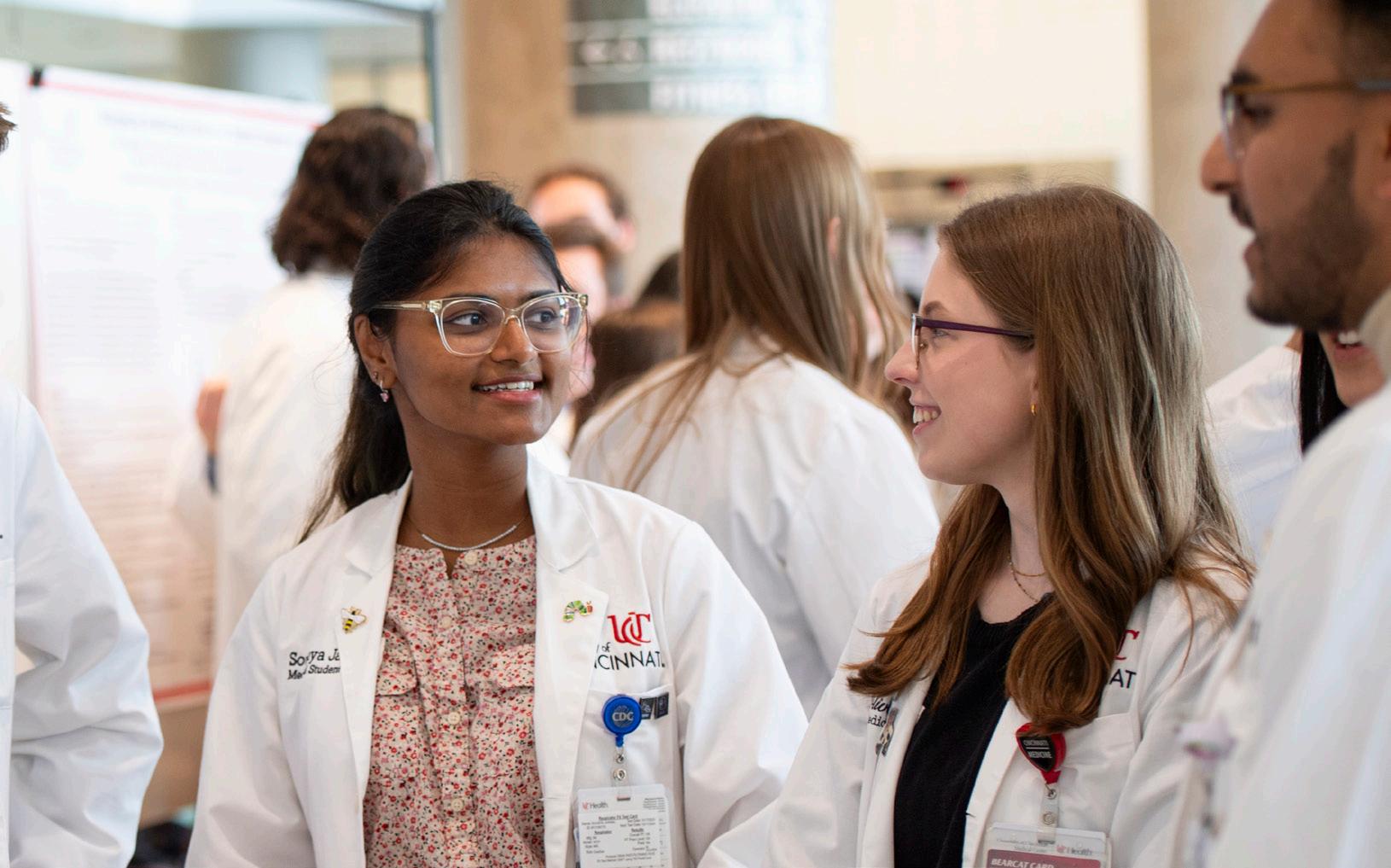
MEASURES
OF SUCCESS
Philanthropic support will speed our time to impact in the areas of research, patient care and training the next generation. We will track and measure our success in these areas through improved scores and metrics in:
Research
Our research portfolio will grow and be measured by: the number of publications in top level journals, faculty presentations at conferences, and scores/rankings from the National Institutes of Health and Blue Ridge Rankings. Additionally, we will track membership growth in premier research networks such as StrokeNET, Mood Disorders and the Alzheimer’s Disease Research Centers (ADRCs).
Clinical
Investments into personalized medicine and clinical advancements will be measured by: improving patient outcomes (relevant to a patient’s quality of life including symptoms, functionality, and physical, mental and social health), impacting key hospital metrics like decreasing mortality and re-admissions rates, and improving patient safety and satisfaction. These will additionally support our reputation rankings in mass media outlets like U.S. News and World Report.
Education
Being a destination for complex neurological care also means being a destination for the best and brightest talent—from students pursuing our residency and specialty fellowship programs to new clinicians and researchers. As demand increases for limited spots (for example, hundreds of fellowship applicants for 10 openings), so will competitiveness and the strength of applicants, along with the quality of care and research across the institute. Professional physician networks like Doximity and professional organizations like Association of American Medical Colleges will help us measure this.
THANK YOU
We’re grateful for your thoughtful consideration of a leadership gift to UC’s Comprehensive Stroke Center, in support of our 10-year Vision for Neuroscience.
CONTACT
Emma Laverty
Associate Vice President for Development University of Cincinnati Foundation
Emma.Laverty@foundation.uc.edu
610-331-9046

To learn more about how philanthropy can make a meaningful impact, scan the QR code or visit foundation.uc.edu/ucgni/stroke
